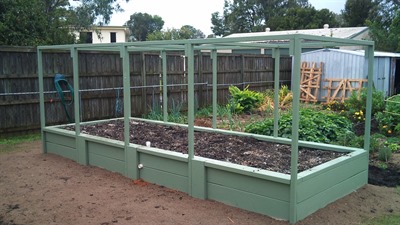
Wicking Beds
Over the weekend I finally got motivated and completed the construction of the hugulculture wicking bed and frame for the pest exclusion material. I have been a bit handicapped lately with lower back pain. I wrote about that here lower back pain. This post will be mainly pictures and a few comments so you should shuffle through it pretty quickly.
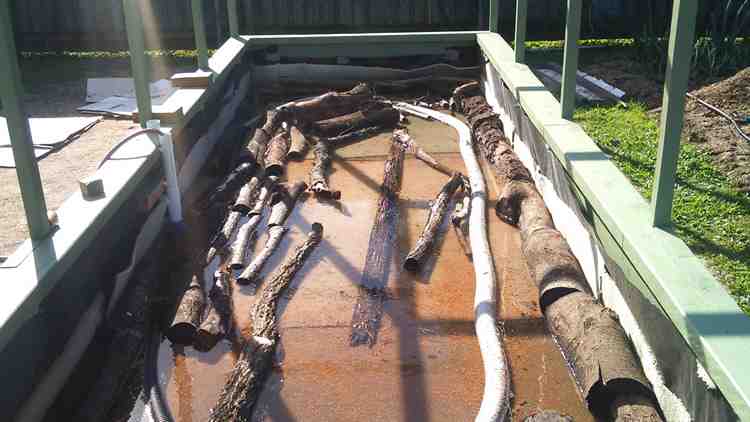
Testing the hugulculture wicking bed for leaks
The bed didn’t appear to leak so I started to carefully place the wood in to create the hugulculture effect. The carpet below the plastic and above it helped with protection, I am sure.
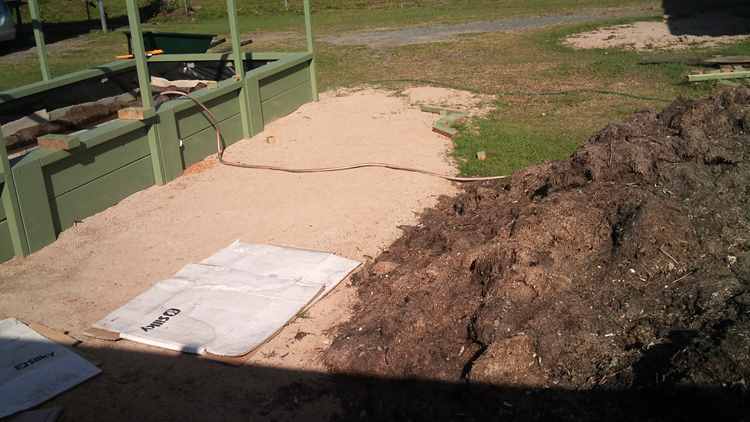
The next job was to move the compost
After adding the wood, the next job was to move the compost. When Gino was preparing the site with the skidsteer, he moved about 6 cubic metres of compost to this position close to the bed. It made it a short trip for each barrow load.

At the halfway filled mark I added lime and rock dust
The compost had been maturing for 12 months and was looking like a really good growing medium. I added minerals and lime at the half full mark.

Wicking bed all filled with compost and another addition of lime and minerals
After adding the compost, I added another dose of lime and rockdust as well as some blood and bone. I will water this in and the bed will settle a bit. It’s raining at the moment so I may not have to water it in.
The white pipe on the side of the bed is the overflow pipe. It is connected to the filler pipe and the ag pipe that goes around the base of the bed. This pipe is slotted so the water can spread quickly through all of the bed.
The overflow pipe is there in case it rains very heavily (quite likely in Brisbane) and water needs to be evacuated. The ag pipe will collect water as well as distribute it and it will rise up and out the overflow outlet. The other reason is in case I forget to turn off the hose when I am filling the bed.
This weekend I will get the pest exclusion fabric on and work out how to access the bed easily. I will also get some wire hangers in and will be able to show you some good ways to tie up tomatoes. I have bought some Black Russian tomato seed and some Roma. I will plant one of each in the southern end. Thats all for now.

Health and Fitness
You may have worked out from the timeline on the posts that my work rate has slowed down a bit. Especially with the wicking bed construction. They are building a two story house two doors up and the subbies must be laughing at the old bloke down the road.

Lower back pain has slowed me down. In the time it took me to build the hugulculture wicking bed, look how far they have got with the new house build.
They started building about the same time I got the bobcat bloke Gino in to level the site. I had already painted the cypress sleepers with one coat and cut them to size when they laid the concrete slab. In the time I got to building the bed and filling it with soil, they have dug and poured the footings, done the rough in plumbing, poured the slab, stood the frames for the ground floor, done the floor for upstairs, stood the second story frames, put up the scaffolding for the gutters and downpipes guy, installed the roof and insulation, installed gutters, removed scaffolding, second roughin for plumber, electrician initial roughin, airconditioning roughin, computer wiring guy, windows installed and are now working on the gyprock install.
Me, I’ve put together a 5 metre by 1.8 metre wicking bed and added the frame work for my pest exclusion material.
Lower Back Pain
The reason I have been a bit slow is lower back pain. Just looking at a 2.4 mtr, 20cm x 5cm cypress sleeper was hurting, let alone bending over and picking it up from the ground. The following might give you an idea of how I was feeling. I make my own compost and I wanted to transfer some to the garden from one of the big piles.
Not the cure for lower back pain
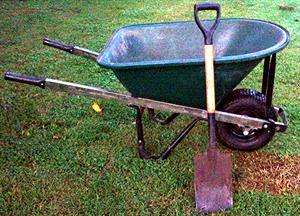
The cure for lower back pain – NOT!
I got the wheelbarrow and a spade. A spade is a lot smaller than a shovel and was about all I thought I could manage. I wasn’t rushing as I new it was not going to be the easiest of tasks. I loaded the first spadeful and was thinking that I should be able to keep going. The second spade full wiped that idea. The only way I was going to get this done was to get down on my knees and shovel it in from there. That way I didn’t have to bend. Going slowly, I was able to move four barrow loads of compost to the garden. But I knew something needed to be done if I was going to get the things done in the yard that I wanted to do.
I don’t like going to the doctor. I reckon most of them are a blight on society and are just legalized drug pushers. That’s not to say I haven’t known some great ones and been impressed with their knowledge and human kindness. The problem is me, I dislike taking drugs, tried that, think it’s a waste of time and life. So I needed to do some internet research. So armed with the knowledge I knew where the pain was, lower back and right hip, I went to work. I also thought that I had been sitting on my arse too much using the computer and that I had stopped playing sport. This made me head in the exercise direction.
I came up with the following exercises that haven’t cured the pain but have made it much more manageable. There are days when I think I am floating, I feel like James Brown.
Go to this url http://breakingmuscle.com/yoga/heal-your-lower-back-pain-with-these-5-yoga-poses?page=0,0

Supine Hamstring Stretch
This exercise seems to be helping a lot. I can feel that my right leg is a lot harder to straighten and get to the vertical.

Two-Knee Twist
When you go to the page you will get all the instructions on how to do them properly. I do the first three at the moment. When I started I was gung ho and did them all but found I wasn’t as motivated after three days, so dropped it down to the first three. I now find I am increasing the times spent holding each position.
Breathing and counting
I have found that to time myself I breathe in while counting: and 1 and 2 and 3 and 4 and 5 then I breathe out: and 6 and 7 and 8 and 9 and 10. I count to sixty and repeat three times on each leg for the first exercise. I count for two minutes on the second and third exercise.
I have confirmed my suspicions that a couple of old sport injuries have contributed to the pain I am feeling from these exercises as they highlight the areas I have difficulty with. Like in the above picture, there is no way yet that I can lay one leg on top of the other doing that twist, the upper knee sticks up about 15 cm from the lower knee. My right hip has pain and that is the knee that sits up the most from the lower knee.
Has it done any good for the lower back pain.
I have been doing these now for three weeks and on the weekend I was able to fill up the wicking bed with some logs and about 5 cub mtrs of compost soil. On Monday night I found it difficult to get off the couch, I had to rock a bit to get some momentum but I was fine on Tuesday and Wednesday. So for me yoga type exercises are a must. I need to develop the habit of doing them on a daily basis.
I will also look for a few exercises to improve my stomach muscles and core as I think they will help as well. I have learnt to approach these things slowly as experience tells me that when I go all in to start with I find it difficult to maintain the enthusiasm to persist. If I start slowly and master a few techniques and stop myself from trying to be perfect in the first couple of days I start to light a slow burn wick that gets brighter over time.
You may have gathered that I am a bit of a tight wad and loathe wasting money. I also believe that the answers are already there in your head, you just have to slow down enough, listen to the voice inside and act on that internal knowledge.
PS: As a child learning English at school I was told repeatedly, “when writing a composition, don’t start your sentences with I”. On re-reading this post, I find that nearly every second sentence starts with I. It will take quite a bit of thinking and time for me to change all the sentences starting with I, therefore I am leaving them that way. If you have any suggestions that makes it easier to write a sentence without starting with “I” then I am all ears. Would love to hear them.
All the best Olman
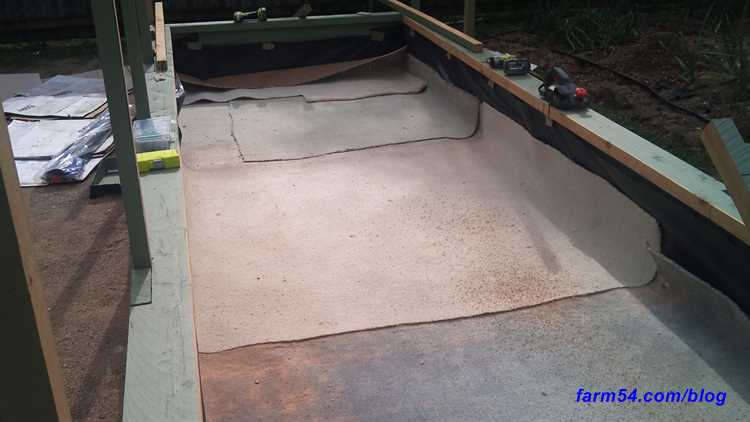
Experiments
It is taking longer than I planned to build the wicking bed, but I got a lot closer to completion today. The completion is in sight and seeing that I want to plant by the winter equinox, 22 June, I think that it will be achieved.
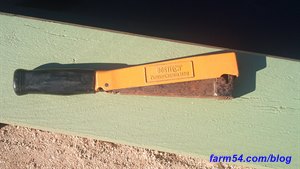
A hammer stapler helps intstall the plastic liner
There were a couple of items that I was procrastinating about, getting staples for my hammer stapler and getting some old carpet for the base.
The carpet might seem unusual, but I wanted to have a base that would protect the plastic liner. I needed to source some carpet that had been pulled up from houses. After mucking around and looking on Gumtree for free carpet for a week or two, I finally hit upon the idea of going to a carpet shop and seeing if they had any carpet that had been pulled out of houses where they laid new carpet.
Sourcing carpet for the wicking bed build
I strolled into Just Carpets, Virginia, spoke with Darrin and he took me down the back to a big pile of rolled up carpet and said, “Help yourself, take it all if you want.” I loaded four rolls into the car and drove off feeling pleased with the trip.
On Friday, I wrote a list of things I wanted to complete by Sunday
- carpet wicking bed
- plastic lining installed
- plane edges of uprights
- finish sides and tops

A layer of carper was intsalled before the plastic liner

Installing the plastic liner

The rest of the carpet was laid on top of the liner giving it protection when I worked in the bed
I was able to get all the above done.I still have the following to complete before planting:
- finish painting
- install the agpipe and filling spout
- fill with soil and compost and water
- install shade cloth
- install wire for trellising
- plant
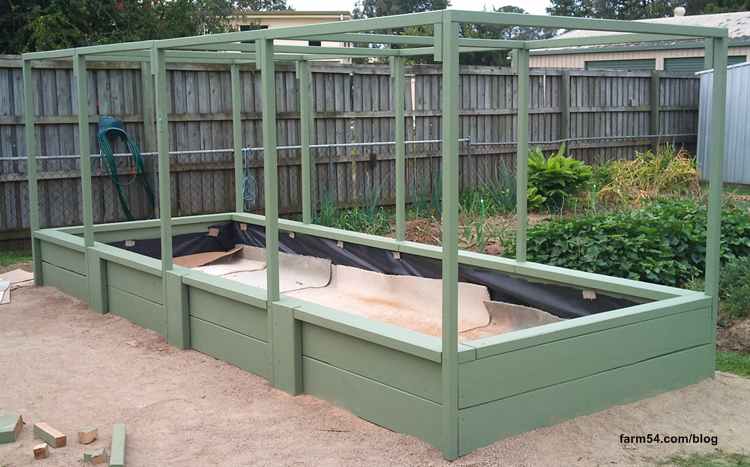
Painting done, the wicking bed is now ready to fill, then shadecloth
A couple of years ago I used a Silky pole saw to reduce the height of a macadamia in the back yard. It was close to 12 metres high (40ft). I cut the branches into small lengths and stacked it up. I now have a use for it. I will turn this wicking bed into a hugulculture wicking bed. (see this post on hugulculture)
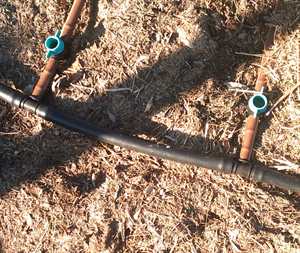
Experiments
The easiest way to do your watering is to set up a garden watering system on a timer. I know, sounds like hard work, but this is the easy way to water the garden so that it happens automatically without you doing a thing or having to go out when you come home from work and battle the mosquitos at sunset after a particularly hot day.

Dripper Lines make garden watering systems practical
Most people, when they go to the big box hardware store look at the irrigation section and get all stressed about buying the pipe and the fittings and fitting the little spray thingies into the pipe. There is none of that. Instead we use the dripper line, where the holes are already in the pipe and the water drips out, usually at a set rate of 2 litres per minute.
Get the drip rate and do some sums
The first thing to do is to attach a hose to the tap and fill a 10 litre bucket and time how long it takes. In my case it takes 20 seconds. From that we work out the tap flow rate.
10 litres in 20 seconds equals 30 litres in a minute, multiply by 60 minutes (1 hr) and we have a flow of 1800 litres per hour from the tap.
This 1800 litres per hour means that I can work out how many metres of dripper line I can run so that the drip rate is 2 litres per hour from all dripper holes. The dripper line I use has 3 drippers per metre. So if I divide the 1800 by 6, I can run 300 metres of dripper line.

Calculator for dripper lines
Still with me. To make it easier, I have devised a little spreadsheet to work it out. All you need to do is put in the numbers and it will tell you how many metres of dripper line you can run from the tap. The reason I put the tap in is that you will most likely run a hose to the garden and clip it into your dripper system. I haven’t got around to digging a trench for a pipe to the garden yet.
To down load the spreadsheet, go here and enter your email address. You will also receive an email when I have made a new post.
Putting your garden watering system together

Diagram of the garden watering system layout
I use a 19mm black poly pipe for the header of my system. The header is where the dripper line is connected to. I have inserted a tap at a lot of the dripper lines, but so far haven’t needed to adjust the watering for various crops.
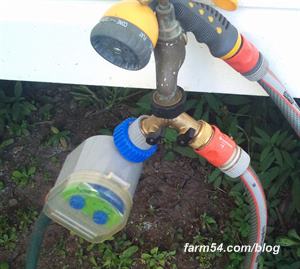
Watering timers are simple, robust and easy to use
To automate the process a timer is required. They are so cheap these days and reliable that every garden should have one. The one you see pictured is simple to operate, can be programmed to water daily, twice daily or monthly. The combinations are endless and easy to work out. I runs on a couple of batteries that have been there for over 12 months. If it is raining, I just turn the water off. The timer keeps opening and closing the valve to the presest times, but no water goes through.
I put a splitter on the tap. After getting two cheap ones that leaked, I finally purchased a good brass one that hasn’t been a problem so far.
Hose Connection to garden watering system
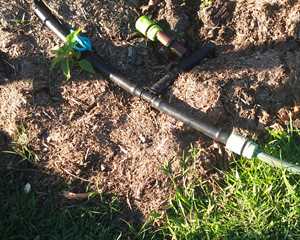
Hose connected to header pipe
A hose runs from the timer to the header pipe of the watering system. The header pipe is 19mm diameter and the dripper lines are 12mm diameter. If I get around to putting a line underground to the watering system I will make that 19mm as well. I have extended my watering system to another bed. The tap has enough water flow to water both garden beds.

By adding taps you can reduce water to areas
To connect the dripper lines to theheader pipe, cut the header pipe at the dripper line position, insert a 19mm T piece with a 12mm T outlet and push the dripper line onto the 12mm outlet. If you want to place a tap in the line add a 50mm piece of 12mm pipe with the tap attached.
Placing mulch on top of the dripper line is a benefit as it stops evaporation. It doesn’t harm the dripper lines.

Natural Gardening

The leaves start to yellow as ginger gets close to harvest
A Sub-tropical climate is perfect for growing ginger. Brisbane in Australia is ideal. From my experience with ginger it is a very easy crop to grow and doesn’t take much maintenance.
I started by planting some ginger from the supermarket. I made sure that it was Australian ginger as this would help prevent introducing an overseas disease into my backyard.
Growing ginger from thumb sized pieces

Good buds or eyes and firm piece
All I did was pick all the small pieces out of the tray that looked like they had a growing tip or bud or eye. In most cases they looked like they were starting to grow. I handled them to make sure they weren’t soft and mushy as I felt that this indicated they wouldn’t rot in the ground.
When I first started I didn’t have any clue about the best time to plant, length of time before harvest or the best time to harvest. Over the last two years I have learnt a few things and can give you a few guidelines for growing ginger.
- Best time to plant – early spring
- Best time to harvest – when the leaves have died down Autumn/Winter
- Best growing environment – fertile soil, compost, moisture but not waterlogged, humid tropical environment. Some say partial shade is required, but I have found that ginger can be grown in full sun. I have dripper line irrigation on a timer so that the soil is kept moist. Perhaps this allows the ginger to grow in full sun.

The best part of growing ginger, besides eating is harvesting
I have just harvested some ginger and replanted some of the rhizomes in a new location. This location only gets sun in the morning, so it will be interesting to see if the ginger grows better or worse than in full sun.
There is still quite a bit of ginger to harvest and seeing as the leaves are still mostly green I will leave it a while longer before digging further.
In the top picture some of the leaves are greener than the others. The drier yellowy leaves are from the ginger left in the ground from last year. As mentioned I knew nothing about ginger when I first planted it. I harvested most of the ginger and left the rest in the ground to grow again the following year. It has definitely regrown as you can see from what I have harvested so far.
Leaves still green

Leaves of the small pieces planted are still green
The leaves that are still green are from ginger planted from the bits from the supermarket. On a number of occasions through the year I purchased some small corms and just put them in the soil. The results surprised me as most of them grew. I now have a rather large stock of ginger that I will replant in new locations.
Growing ginger is satisfying and easy to do. If you have a small area, even in the flower garden, bury some corms with the bud side up and be surprised at what you harvest. The leaves look good too and make a great background to more colourful plants.
Replanting a piece of ginger

From the left: Thumbsize piece of ginger, Choose location, Plant ginger eyes up, Cover ginger lightly, Mark the spot. Leave it alone for at least 8 months. It’s that easy

























